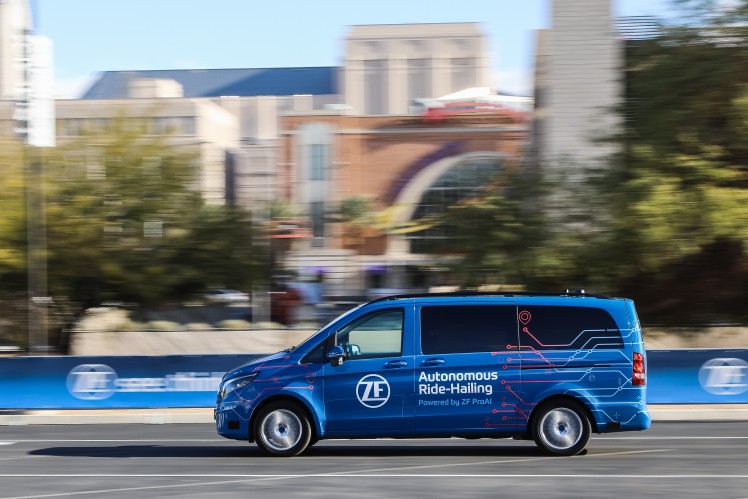When personal mobility is restricted or even prohibited, protests are inevitable. “We all have to and want to work on this evolving crisis in order to improve the situation,” explains Wolf-Henning Scheider, CEO of ZF. In a widely acclaimed speech at the 21st Technical Congress of the German Association of the Automotive Industry (VDA) in Berlin, he called for a pragmatic and technology-agnostic approach to meet these challenges. The mobility of tomorrow will primarily manifest itself in electrification, automation, and cloud-based services.

Technology
#SmartMobility
A Pragmatic – Not Dogmatic – View of Mobility
Min Reading Time
Driving restrictions are an example of how the conflict surrounding individual mobility is becoming increasingly acute. ZF is committed to pragmatic and non-proprietary solutions to effectively meet the current challenges.
Electrification just beginning to pick up steam
Anyone who takes a holistic and sober view of electric transportation will soon realize that all-electric vehicles are not a short-term solution. Some facts show why that is:
- In 2018, a total of 94 million new vehicles were registered worldwide, including vans and pickups. Of this total, 2.23 million were electric vehicles, i.e. plug-in hybrids (PHEVs) or battery electric vehicles (BEVs). Considered in absolute terms, that’s already a respectable number. At only 2.4 percent of the total, however, this figure shows how much growth potential remains.
- The number of charging stations has increased massively so far this decade. In 2010, there were only around 7,700 charging locations worldwide, but by 2017, the figure had already grown to over 748,000. The average annual growth rate stands at an impressive 92 percent – with China driving most of this growth. The number of charging points has also increased significantly in Germany, with 16,100 charging stations in operation at the end of 2018. Yet there are a total of 150,000 electric vehicles on the road, i.e. PHEV and BEV, which corresponds to a ratio of 1:9. Although this ratio is, on average, sufficient to guarantee a supply for every electric vehicle owner, it should be noted that the share of electric vehicles out of the total population is still extremely low.
92
percent
was the average annual increase in global charging points between 2010 and 2017
- Even if the charging infrastructure were significantly expanded, the challenge of sustainable and renewable power generation still exists. Around the world, large quantities of fossil fuels continue to be used to produce electricity. In 2016, fossil fuels generated 72 percent in China, 65 percent in the United States, and 56 percent in Germany. This means that electric mobility is not yet carbon neutral.
Drive Concepts with Range Needed
So what needs to be done to ensure that electric mobility can be used more widely? A key obstacle is consumer uncertainty, particularly with respect to range. Yet a glance at the statistics shows that many everyday mobility requirements can already be met with a fully electric range of 80 kilometers. In Germany, for example, 75 percent of all commuters travel less than 25 kilometers back and forth to work – a total of 50 kilometers per day. In addition, 90 percent of all individual trips are less than 40 kilometers long.
This means that in order to help electric mobility truly succeed, increasing vehicle range must be a top priority in order to counteract people’s fear of “running out of power.” "We must implement a fully electric vehicle concept that is capable of meeting the mobility needs of an average family on a daily basis, and whose acceptance is not simultaneously limited by fear of range,” explains Scheider.
A Potential Solution: Transforming Plug-In Hybrids into EVplus
A technology that can be used to overcome the identified issues already exists: the plug-in hybrid. Vehicles with combustion engines and first-generation electric drive systems don’t enjoy the best reputation today, however. The main reason for this is that their electrical range is still inadequate and that the concept is not universally adopted in all vehicle classes. But the technology works and is available. This means that the latest generation of plug-in vehicles will have to provide a far greater electrical range. “We at ZF call the next generation of plug-in hybrids EVplus. Viewed overall, this generation will allow the majority of all trips to be taken entirely on electric power,” says Scheider, explaining the concept. “We believe a range of 80 to 100 kilometers is guaranteed.”
EVplus with Best Performance Overall
If all factors are taken into account, EVplus has an edge in terms of CO2 emissions and costs compared to BEV and vehicles powered exclusively by an internal combustion engine. In this context, ZF conducted an analysis of a C-segment vehicle over its entire life cycle of 150,000 kilometers driven. If the vehicle uses its electric drive for 80 percent of its total mileage and the internal combustion engine for 20 percent, a PHEV with today's power mix performs better than the other two drive types in terms of total CO2 emissions in Europe, China, and the United States (see chart).
PHEVs also offer cost benefits. These are mainly determined by a significantly smaller battery compared to a BEV with a comparable range.
As such, Mr. Schneider is certain: “From a pragmatic point of view, we can already draw on technologies that will help us achieve our ambitious and stated goals. We only have to address the mobility issues of today and tomorrow in a technology-agnostic and impartial way.” ZF already offers a wide range of driveline components for hybrid and fully electric vehicles, from scooters to passenger cars and commercial vehicles.
“We have to address the mobility issues of today and tomorrow in a technology-agnostic and pragmatic way.”
New Forms of Mobility as a Supplementary Alternative
ZF’s “Next Generation Mobility” is based on more than just electrified drives, however. It also means connectivity and automation. The goal: intermodal mobility. “Today, artificial intelligence, deep learning algorithms, and neural networks make it possible to efficiently connect different modes of transport,” says ZF CEO Scheider. An extensive range of sensors inside vehicles, the ZF ProAI RoboThink, currently the world’s most powerful automotive supercomputer, and intelligent mechanical components will together allow mobility-as-a-service and transport-as-a-service solutions to quickly become reality. At the Consumer Electronics Show (CES) in Las Vegas in early 2019, ZF used a demo vehicle to show what a connected ride-hailing service with an autonomous van might actually look like.
With its products and services, ZF is helping shape the mobility of the future – without restrictions and increasing conflict. “The key to the mobility of the future, however – which we all want to and must shape together – is a pragmatic, technology-agnostic approach,” says Scheider.









